I have the privilege of travelling for work to the Central West of New South Wales twice a year. After hours are typically my own, and I usually take those opportunities for photography. The night after night of clear and dark skies out there are wonderful for star gazing (though I can never help thinking of the heartache of the drought ravaged farmers praying for rain clouds). I usually shoot digital for very low light photography, such as astrophotography landscapes. There is really no other easy way to get a landscape at EV-5 and the Milky Way core above both acceptably lit and sharp in a single frame capture.
On this occasion, though, I took my Olympus OM1, a wide lens, the Zuiko 18/3.5, and Fujifilm’s Natura 1600. I had been inspired by Murray Fredericks analog photographs on the salt plains of Lake Eyre. He used a large format analog setup with Fuji slide film to make extraordinary images of the sky and stars reflected in a large mirror and the salt. I was determined to try astrophotography landscapes on analog too.
Unfortunately, other than a few scraps of information I had heard in interviews of Murray on his work, it is difficult to find a lot of information on analog astrophotography from the interwebs. I knew I would be catching star trails, as I would not be using a motorised gimbal (I don’t have one, and I want a landscape, not an isolated Milky Way core). I knew I would want a fast film, as I did not intend to leave a camera or myself out all night, as Murray had. I knew I would want a mechanical camera, as I did not want battery issues on the long exposures. My Minolta Maxxum 5 ran out of juice on preliminary experiments the previous year, and there are specific warnings about an unmodified Pentax 6×7 expiring it’s battery, particularly as the Pentax’s electromagnet is actively holding the mirror up the entire time the frame is exposed.
I knew I wanted a wide lens, as I like images with the galactic core spread across the heavens and compositionally balanced above the earth elements. I would also prefer a fast lens, as a 1 stop change in exposure could mean an extra hour in extremely low light. Hence my equipment choices. The OM1 is fully mechanical, and also has a mirror lock up feature that is helpful for long exposures. The Zuiko 18/3.5 isn’t the fastest of lenses, but it is remarkably wide with very acceptable distortion, and of a focal length I usually shoot at in my digital astrophotography landscape images. I could live with the compromise in speed.
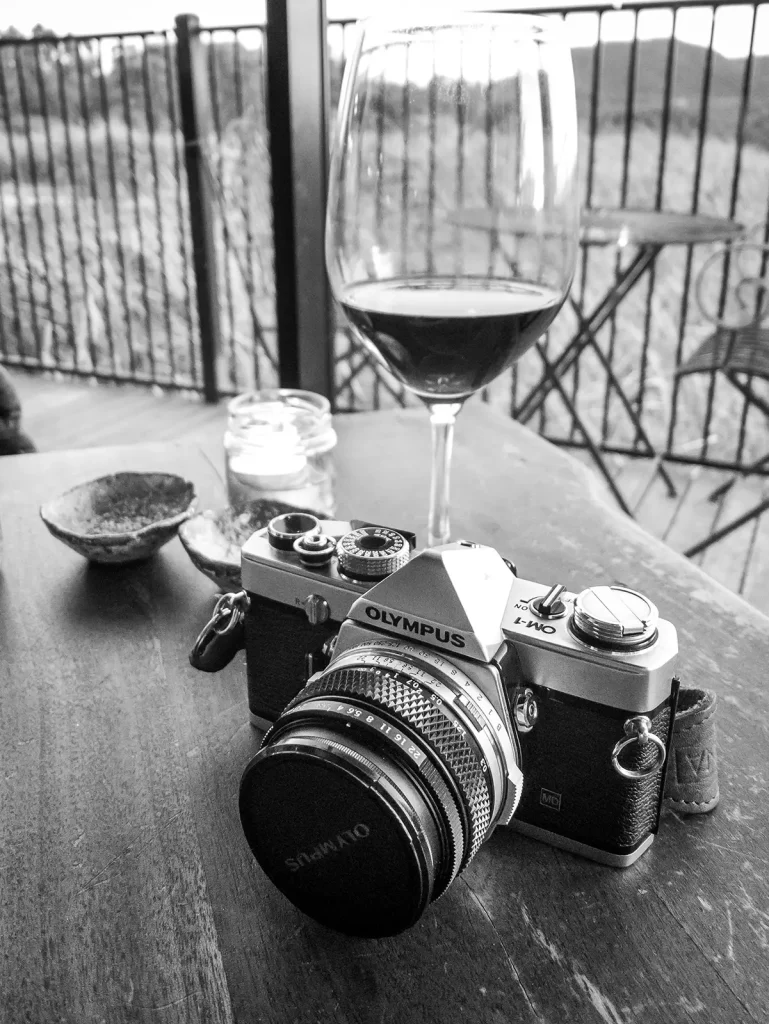
Fujifilm’s Natura 1600 is sadly now defunct and can cost the equivalent of an OM1 for a single roll on the ‘Bay, but I still have a few rolls from before the extinction event. It seems to be one of the films recommended for analog astrophotography, I guess for obvious reasons. It would allow me to have acceptable exposure lengths even at EV-5 with my lens combination. Reciprocity was going to be an issue, and I really couldn’t find much on Natura 1600’s characteristics. I was in a bind about about testing this for myself with this now precious film stock. I decided to add 1 stop and hope for the best.
In the end I captured four star trail images for a total exposure of 3 hours. I present these here as well as a couple of dawn images. The combined exposure time for the rest of the roll would be a tiny fraction of the time it took to capture the star trails.
On the nights of these photos there was good moonlight from something like a quarter moon, desperately important for capturing any detail in the landscape, particularly on film. Even so, the light was too dim for metering. Instead I used an exposure guide, and as an example, this gave me settings with a quarter moon at EI1600 at f/3.5 of a 30 minute exposure, which I would then expose for 1 hour to account for reciprocity. The resulting astrophotography landscapes show black nighttime skies turning blue, a combination of the natural light and colour shifts in the film. The landscapes themselves are mysterious and remain hidden with only prominent features emerging from the heavy vignetting. I love the star trails.
The first two images are from Burrendong Dam, tragically at less than 5% capacity due to the drought at this time. The first image is on the dam itself, and the second overlooking the reservoir. The first was exposed for 1 hour wide open, and the second for 30 minutes, both using the exposure guide rather than direct metering. There is definite vignetting and the landscape remains underexposed, but perhaps acceptably so.
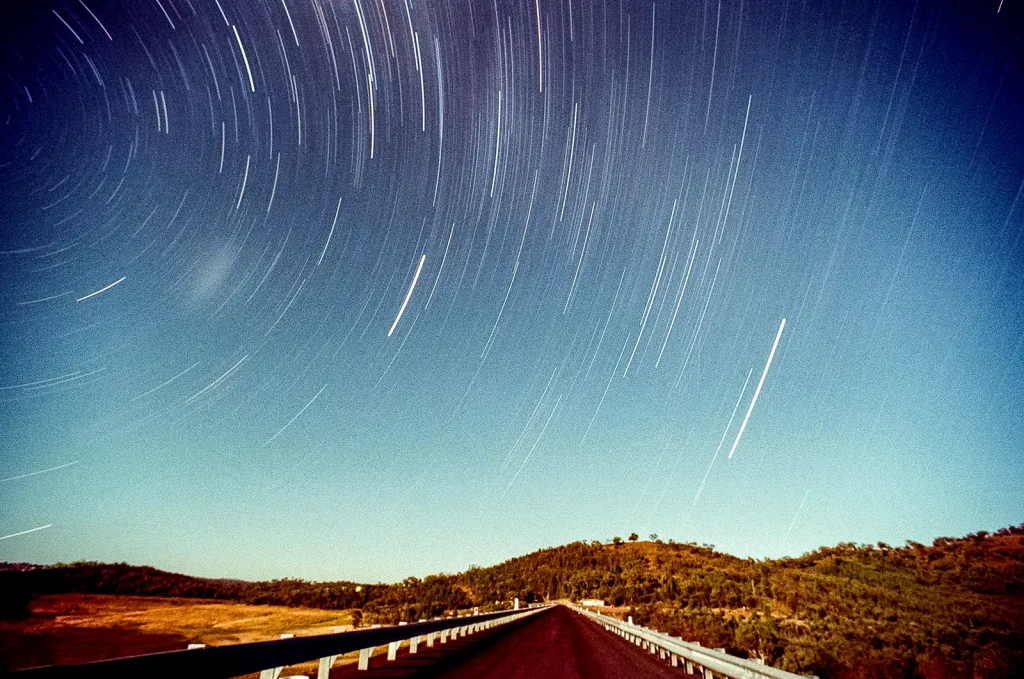
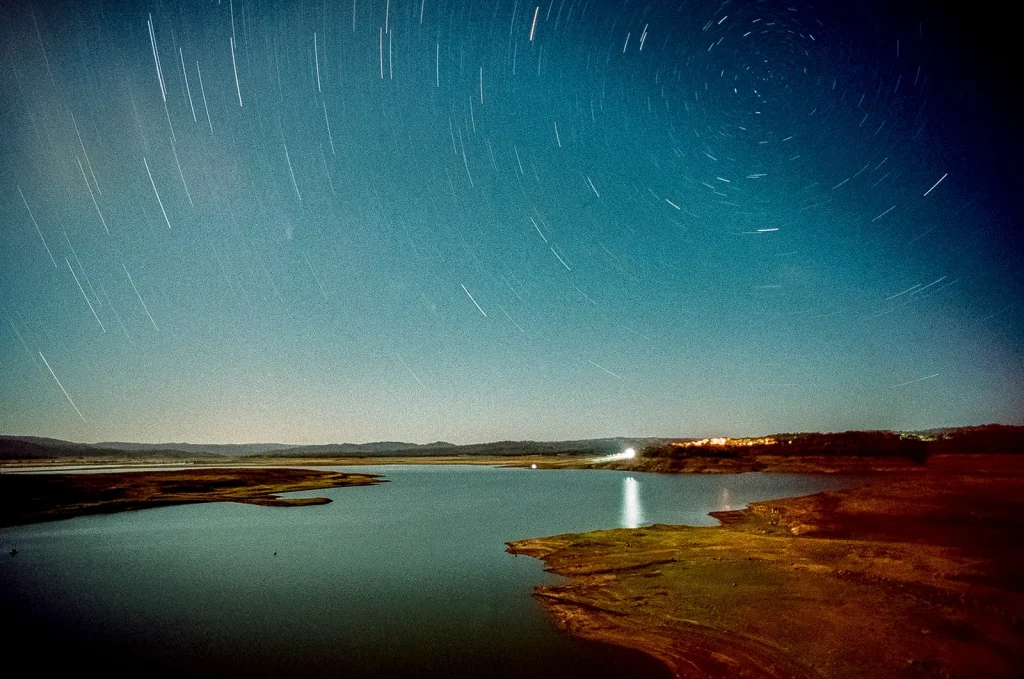
The next image was close to Dubbo by the side of the highway, pointing due south, the landscape also lit by passing road trains and cars, and exposed for 30 minutes. I had worried that the additional light from the sparse road traffic would be too much, but I should have known the negatives would simply soak up that light. There is no Pole Star in the southern hemisphere, and calculating south from the stars requires drawing intersecting lines from the Southern Cross and the Pointer Stars. I seemed to have hit the bullseye. Criminally out of focus, I must have bumped the lens after setting up, it is still nonetheless a favourite image.
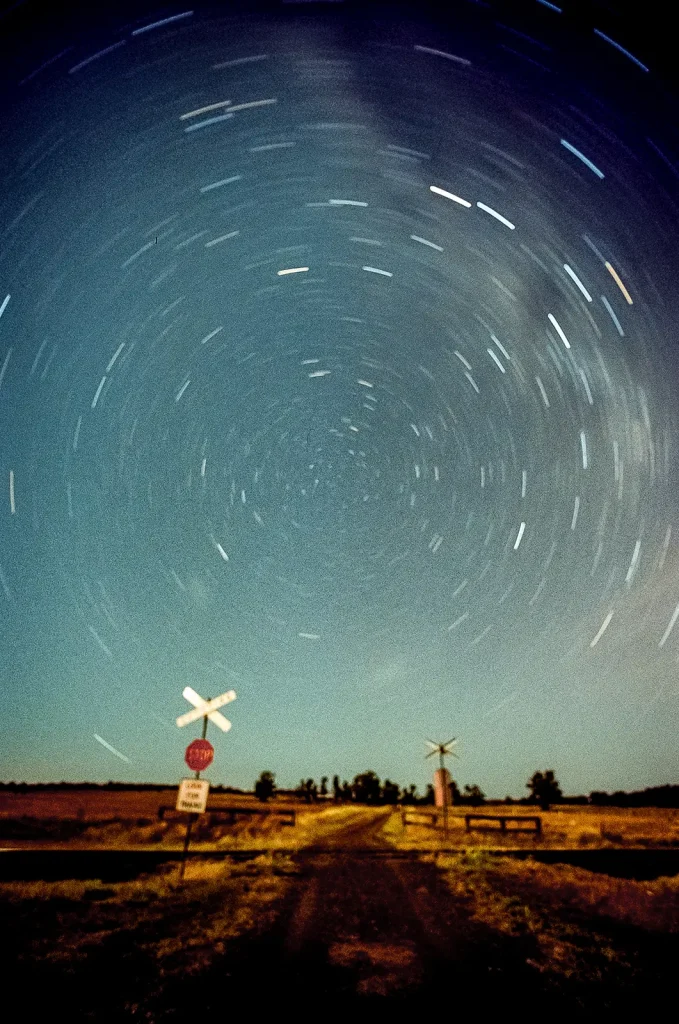
The next was shot near Obley with an overcast sky, and I had not allowed enough for the veiling of the moon to avoid underexposure, despite a 1 hour exposure. The shadows are crushed and unacceptably murky. Film can always handle more light, if you can afford the time to capture it.
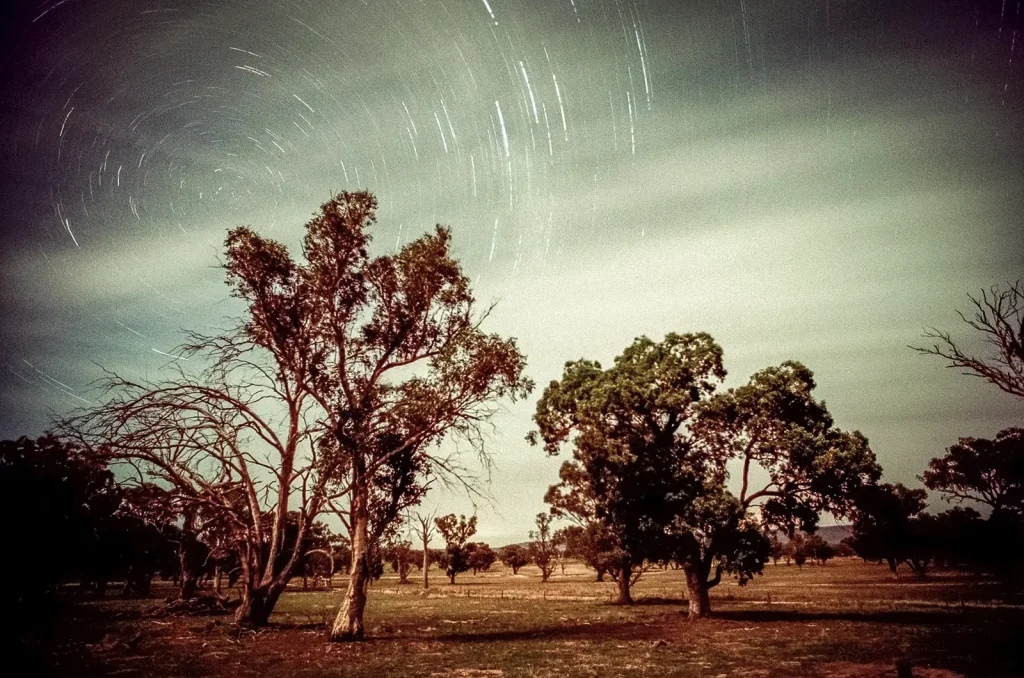
This image is of an abandoned grain silo in Yeoval on my way to work. I had hoped to be early enough to catch some stars in the sky, but it had already brightened too much.
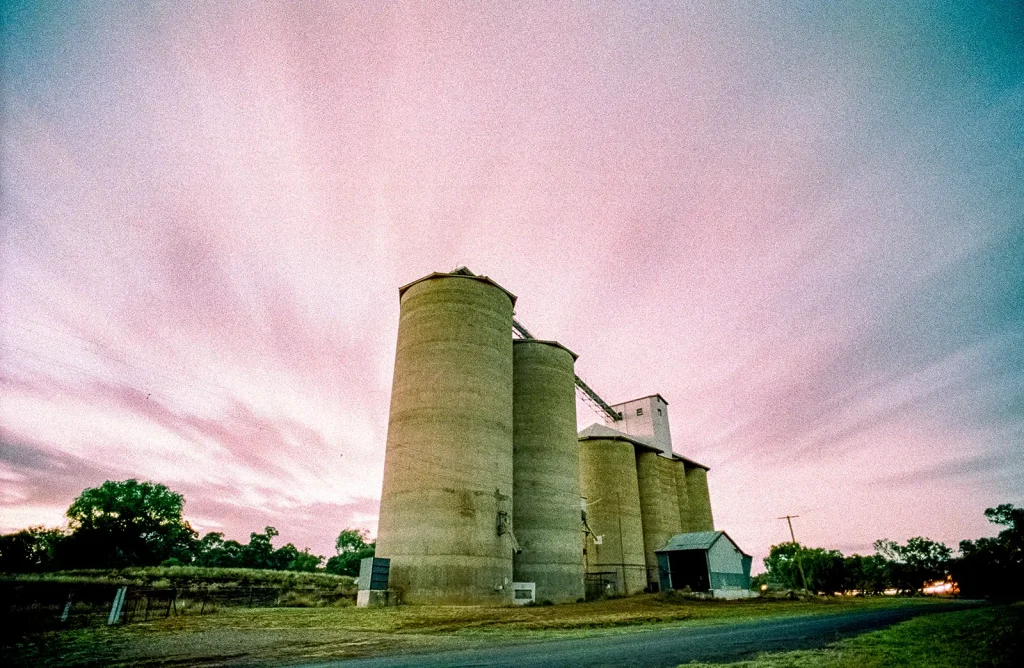
The final image is at dawn near Parkes later that morning.
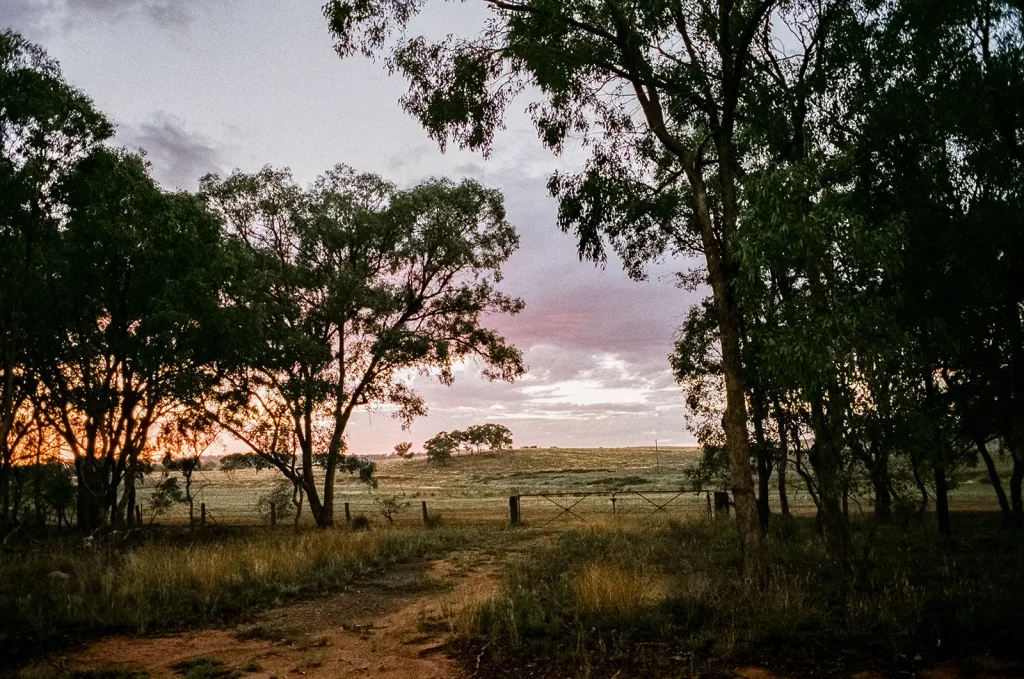
I have been sufficiently encouraged to try analog astrophotography again. Given the time needed to capture an image I am not expecting to capture significantly more frames, and given the grain inherent to some films with long exposures and low light, I am thinking of going to medium format. Next time I will try a 500c/m but I am still debating what film, but it will undoubtedly be slower than Natura 1600. I won’t be afraid of giving the captures more light (time permitting). Hopefully I can report back with images to share.
What do you think?
My thanks to Rewind Photo Lab in Sydney for the processing and scan.
Instagram:
www.instagram.com/billthoo
www.instagram.com/analognights
Share this post:
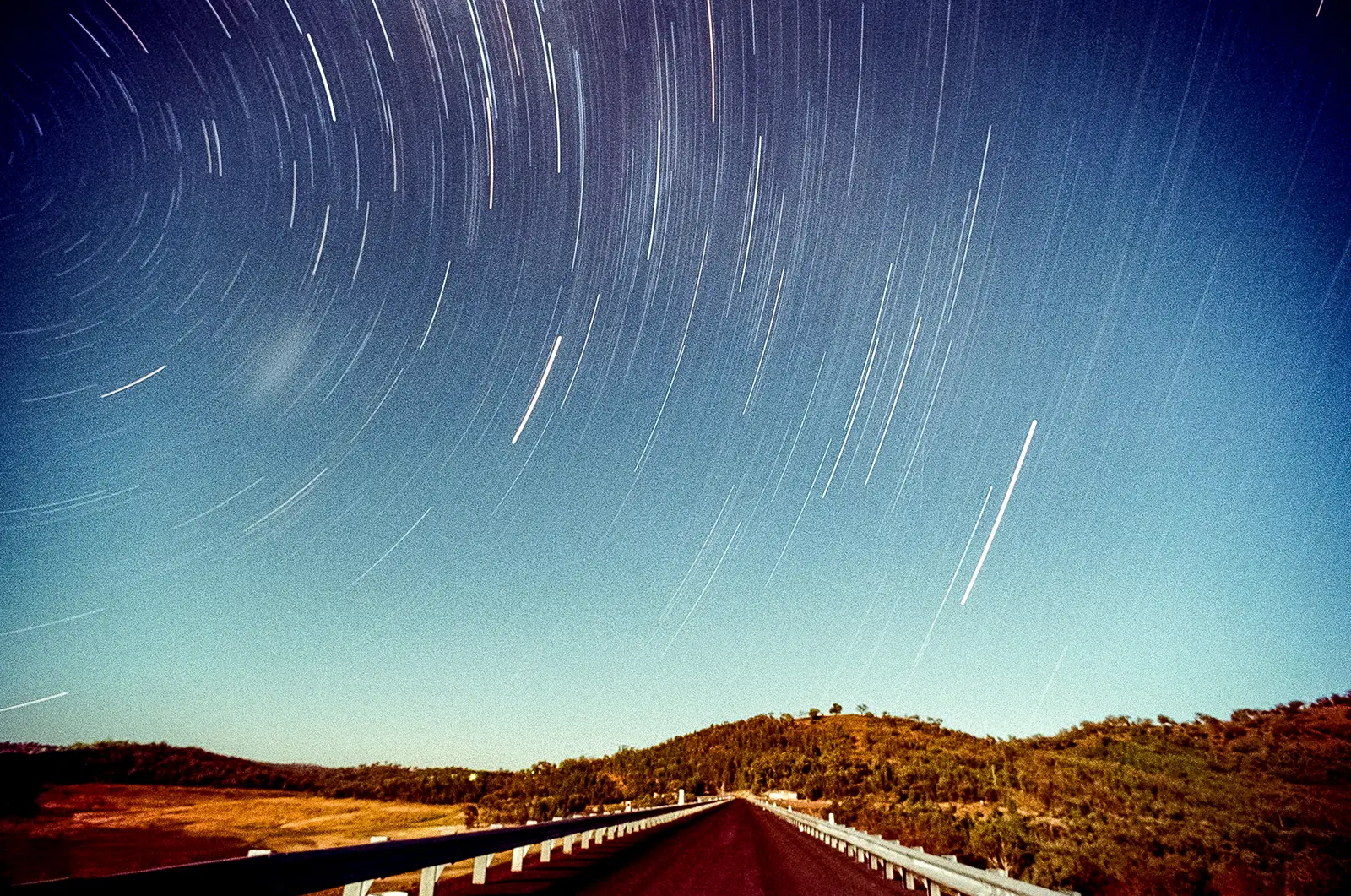








Comments
thorsten wulff on Fuji Natura 1600 & Shooting Star Trails and at Night – By Bill Thoo
Comment posted: 15/11/2019
Comment posted: 15/11/2019
Reinhold Graf on Fuji Natura 1600 & Shooting Star Trails and at Night – By Bill Thoo
Comment posted: 15/11/2019
As I like the wide angle view, I‘m really quite enchanted ;)
Comment posted: 15/11/2019
David Marshall on Fuji Natura 1600 & Shooting Star Trails and at Night – By Bill Thoo
Comment posted: 16/11/2019
Comment posted: 16/11/2019
Rock on Fuji Natura 1600 & Shooting Star Trails and at Night – By Bill Thoo
Comment posted: 16/11/2019
Comment posted: 16/11/2019
Comment posted: 16/11/2019
Swinscow on Fuji Natura 1600 & Shooting Star Trails and at Night – By Bill Thoo
Comment posted: 17/11/2019
I'd love to try some astro on film
Comment posted: 17/11/2019
Matt on Fuji Natura 1600 & Shooting Star Trails and at Night – By Bill Thoo
Comment posted: 18/11/2019
Clear nights are not always readily available here on the West coast of Scotland during the winter, but we do get them... Also the possibility of the aurora too.
I would be more than keen to find details of the Exposure Guide you used here..?
Comment posted: 18/11/2019
Shooting Star Trails with 120 Cinestill 800T - By Bill Thoo - 35mmc on Fuji Natura 1600 & Shooting Star Trails and at Night – By Bill Thoo
Comment posted: 06/03/2020
eric on Fuji Natura 1600 & Shooting Star Trails and at Night – By Bill Thoo
Comment posted: 03/05/2020
The beauty of one place and lights.
Om1 is great my first camera ...
Rewind Lab Sydney is one of best lab on earth, love them because they work very very well. Would like to learn with you, I probably use my Leica and Voigtlander 15mm. Hamksburry River has nice spots too.
Thanks for sharing and great images.
Comment posted: 03/05/2020
daniel hughes on Fuji Natura 1600 & Shooting Star Trails and at Night – By Bill Thoo
Comment posted: 21/10/2020
Comment posted: 21/10/2020
HW Kateley on Fuji Natura 1600 & Shooting Star Trails and at Night – By Bill Thoo
Comment posted: 05/06/2022
Comment posted: 05/06/2022